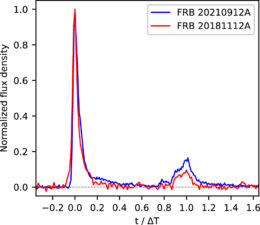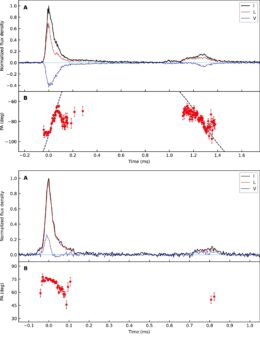Astronomers have discovered two fast radio bursts with eerily similar signals. What’s the likeliest cause of these twin bursts?
Mysterious Bursts

Artist’s impression of a neutron star, the core of a massive star that has exploded as a supernova. [ESO/L. Calçada; CC BY 4.0]
As researchers attempt to parse the similarities and differences among the growing sample of radio bursts into a coherent theory of their origins, a curious pair of bursts has arrived on the scene. What can we learn from a nearly identical pair of bursts?

The flux profiles of the 2018 (red) and 2021 (blue) bursts. The flux has been normalized to the peak intensity of each burst. Note that the times on the horizontal axis have been normalized to the time between the burst components. [Bera et al. 2024]
Twins from Extragalactic Space
In 2018, the fast radio burst FRB 20181112A arrived at Earth after a journey of billions of light-years, announcing itself with a prominent 0.2-millisecond flash of radio waves and a second, subtler signal just one millisecond later. In 2021, FRB 20210912A was discovered, looking oddly familiar: it too was marked by an initial bright component and a later faint component.
Apurba Bera (Curtin University) and collaborators examined this pair of bursts to understand how deep their similarities go. Using data from the Australian Square Kilometre Array Pathfinder, Bera’s team showed that the relative emission timescales — for example, the ratio of the width of the bright signal to the width of the faint signal — are remarkably similar.
The absolute timescales of the bursts are slightly different, which the team suggests could be due to their different travel times. The 2018 burst arrived from a redshift of z = 0.4755, but the 2021 burst’s redshift is unknown. If the 2021 burst occurred at a redshift of z = 1.35 — possible, given a previous estimate of z = 1.18 ± 0.24 — the absolute timescales would be identical as well.
Possible Origins

Normalized flux density and polarization position angle (PA) for the 2021 (top) and 2018 (bottom) bursts. The “A” panels show the total intensity (I), the intensity of linearly polarized light (L), and the intensity of circularly polarized light (V). Click to enlarge. [Adapted from Bera et al. 2024]
Bera and coauthors note that the properties of the twin burst pair match what they’d expect for a magnetized neutron star rotating with a period of 1.1 milliseconds. This is faster than the most rapidly rotating neutron star known, and it’s just below the hypothetical limit on neutron star rotation. This may point to the existence of a sub-class of fast radio bursts arising from neutron stars spinning near the maximum rate.
The majority of fast radio bursts appear just once, but a few dozen are known to repeat. If the 2018 and 2021 bursts studied here fall into the latter category, it could help solve the mystery of their origin: the slow but steady spin-down of a rapidly rotating neutron star would leave a detectable mark on the radio signal.
Citation
“The Curious Case of Twin Fast Radio Bursts: Evidence for Neutron Star Origin?” Apurba Bera et al 2024 ApJL 969 L29. doi:10.3847/2041-8213/ad5966
